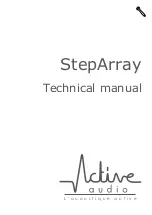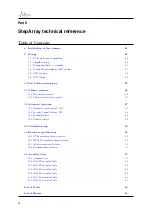
Introduction
This is a tutorial for StepArray recommandation.
Section
presents general issues about public address in large spaces (
) and explains how loudspeaker arrays
can be a good solution to these issues (
). StepArray is introduced as the last point of this section (
The following parts are a step by step introduction to the StepArray system:
• Section
explains the rules to follow when designing a StepArray system,
• Column positionning is described in section
• The different options are described in section
• SAdrive software, serving both as a simulation and tuning software, is described in section
• CAD modeling tools are presented in section
1
Sound reinforcement in large spaces
1.1
General issues with public address in large spaces
Speech reinforcement in large and reverberant rooms is made difficult by several causes, namely
reverberation
,
ambient noise
, and
architectural constraints
.
Reverberation
In all rooms, sound transmission from a loudspeaker to a listener can be divided in two parts (figure
• Direct sound, which depends on the loudspeaker-to-listener distance and on the loudspeaker directivity.
• Reverberated sound, which depends on the geometry of the room, and the acoustical properties of the walls.
In large spaces (church, railway station), the reverberation can be very important and plays a negative role
on speech intelligibility (Note that the energy of the reverberated sound is constant throughout the room).
Direct sound
Reverberated
sound
Figure 1: Direct sound increases speech intelligibility, reverberated sound impairs it.
Intelligibility rule #1:
Direct sound increases speech intelligibility, reverberated sound impairs it.
Last update: December 23, 2010
5






































